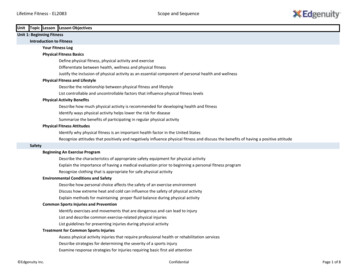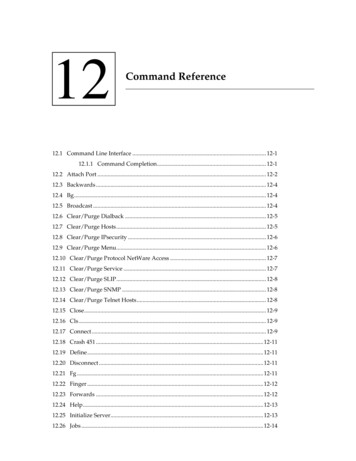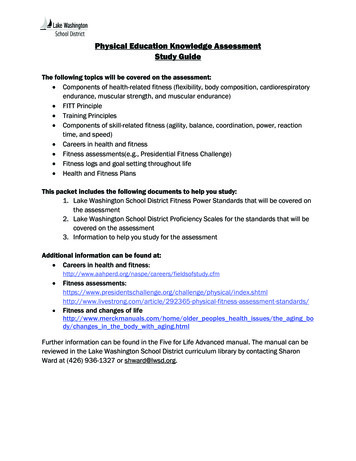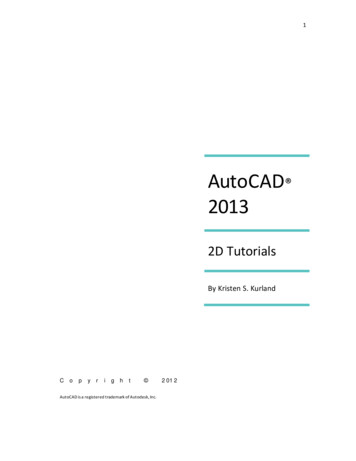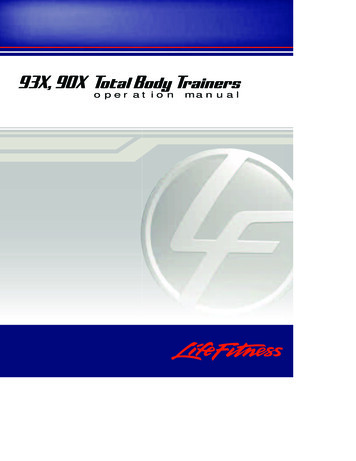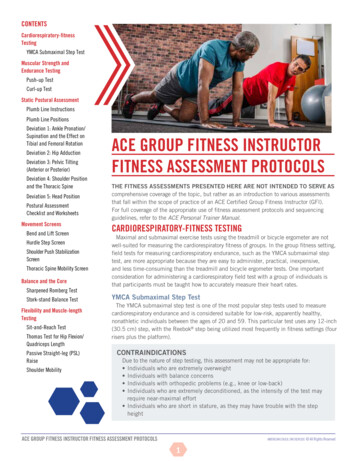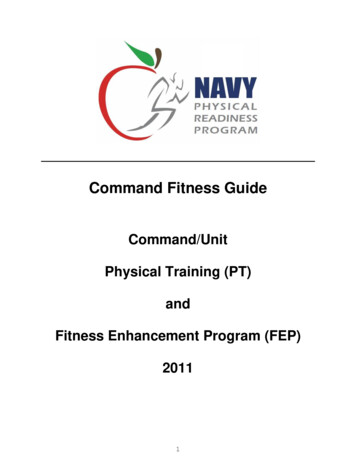
Transcription
Command Fitness GuideCommand/UnitPhysical Training (PT)andFitness Enhancement Program (FEP)20111
Table of ContentsPageChapter 1: Command Physical Readiness Program Overview. . . 3Chapter 2: Fitness Enhancement Program (FEP) Requirements 5Chapter 3: Activity Guidelines . 9Chapter 4: Command/Unit Physical Training (PT) Components 17Pre-physical Activity Questions . 18Dynamic Warm-up Exercises Illustrations . 19Standardized PRT Warm-Up . . 25Dynamic Exercise Quick Reference Guide . . 26Top 12 Navy Stretches . 30Top 12 Stretches Quick Reference Guide . . . 34Things to Avoid While Stretching . . . . 35Contraindicated/High Risk Exercises . . 36AppendixesA. Sample Workouts . 39B. Improving PRT Scores 47C. FEP Monthly Tracking Log. . 50D. Glossary of Terms . 522
CHAPTER 1Command Physical Readiness Program Overview1. OverviewThe command physical fitness program is the command’s action plan to maintain and/orimprove the fitness and health of the entire crew.2. Program StrategiesKey program strategies enhance opportunities for physical activity, increase knowledge,increase availability/access to nutritious foods and decrease availability to foods withhigh calories and low nutrients. Environmental and policy strategies that target theentire command and community (not just individuals) help support healthy behaviors.These strategies are likely to be sustained for a longer period of time than individuallyoriented strategies.3. Medical ScreeningAll members must complete required medical screening to monitor their health statusand screen for risks factors. All members participating in command/unit PhysicalTraining (PT) must have answered “Yes” to question 1 of the Pre-physical ActivityQuestions (Is your PHA current?) and have answered “No” to questions 2-4. The fourquestions are to be asked prior to every command/unit PT session.4. Command/Unit PTCommand/Unit PT is any command led fitness activity. Command/unit PT must be leadby a qualified Command Fitness Leader (CFL), Assistant Command Fitness Leader(ACFL) or Morale Welfare Recreation (MWR) Specialist per OPNAVINST 6110.1J. Allparticipants must wear the Navy Blue and Gold Physical Training Uniform (PTU).5. ProceduresFollow the below are the procedures for an effective command/unit PT session:a. Schedule a location and time for command members to meet.b. Publish location and time to all participants.c. Instruct all participants to bring water (if water is not readily available).d. Always have a plan. Know in advance what exercises will be used in the PTsession.3
e. Ensure ACFLs know their role during the sessions.f. Take muster before and after.g. Read out loud the 4 Pre-physical Activity questions before Command/unit PT.h. Start with a 5-10 minute dynamic warm-up exercise (Chapter 5, Dynamic Warmup).i.Provide directions on alternate options for personnel with limited exercisecapabilities.j.End the session with a cool down and stretches for 5-10 minutes (seerecommended stretches).6. Command/Unit PT Guidelinesa. Activity Guidelines (Chapter 3), provides details on designing PT programs.b. Command/Unit PT Components (Chapter 4), provides details on the componentof command PT. CFLs and ACFLs need to familiarize themselves with this informationprior to conducting Command/Unit PT or Fitness Enhancement Program (FEP).7. Quality Over QuantityMonitor participants during activity. Perform movements in a controlled manner.Remember quality over quantity. When form declines (to the point of volatile fatigue), itis time to stop the movement.8. Commercial ProgramsThe Navy does not endorse any commercialized fitness programs. CFLs/ACFLs arenot authorized to display videos of programs during PT sessions. These programs donot take into account different fitness levels at command PT.9. Emergency Response PlanA safety plan must be in place for summoning emergency assistance. Consult localmedical facilities for guidance. At a minimum, the plan will include telephone numbers,location of nearest AED and procedures for summoning aid and clear directions foremergency response personnel to avoid confusion and ensure their prompt arrival.Include guidance for contacting base security personnel to assist with rapid access ofemergency personnel to test site.4
CHAPTER 2Fitness Enhancement Program (FEP) Overview1. OverviewPer OPNAVINST 6110.1J, “Commanding officers (COs) shall establish and monitor aFitness Enhancement Program (FEP).”2. Program Administrationa. Program Management. FEP is managed by the CFL on behalf of the CO. TheCFL is responsible for administering all aspects of the program. ACFLs play animportant role in assisting the CFL in conducting FEP activities, documentingparticipation, and monitoring progress.b. Program Participation. The FEP is a command-wide program to improve fitnessand nutrition. Any member that fails to meet Physical Fitness Assessment (PFA)standards is required to be formally enrolled into a monitored FEP. For commanddirected enrollment for other than official PFA failure, local written policies (to includecheck-in (BCA) failures and borderline PFA status) are strongly recommended.c. Program Requirements. Mandated FEP requirements are:(1) Written Counseling for FEP Enrollment. Enlisted members are to be issued aNAVPERS 1070/613 (page 13) and officers are to be issued a Letter of Notification(LON) to officially inform them of FEP and nutrition requirements. The Page 13 will begenerated via NSIPS and may be edited to reflect command specific programrequirements. The LON will be generated via PRIMS or manually.(2) FEP PT. FEP sessions will only be led by designated CFLs, trained ACFLs orMWR fitness specialists. It is the CFL’s responsibility to ensure ACFLs administeringFEP are familiar with the OPNAVINST 6110.1J requirements and the contents of thisguide.(3) FEP Hours. Unless otherwise directed by command mission/commitments,FEP activities are to be conducted during normal working hours (a minimum of 3 times,maximum of 5 times, per week for a total of at least 150 minutes).(4) FEP Nutrition. Nutrition plays an important role in performance, weightmanagement, and disease prevention. Each member enrolled in FEP must select anutrition option based on individual needs. Each option must include goal setting, longterm behavior modification and ongoing support. See Nutrition Resource Guide formore detailed information. CFLs will select the nutrition option in the FEP section ofPRIMS.5
(a) Shipshape: Complete the approved course requirements.(b) Registered Dietitian (RD): Meet with an RD and follow sessions as indicated byprovider. Medical Nutrition Therapy for weight management recommends one initialappointment and 3 follow-up visits at a minimum.(c) Self-directed: Create an individual plan including behavior change goals to improvedietary habits and body composition, as needed, by utilizing credible resources as notedin the Nutrition Resource Guide.(1) Nutrition courses such as Mission Nutrition(2) The Good Nutrition Reading List, which is posted on the PhysicalReadiness Program(3) Websites: Navy and Marine Corps Public Health Center links(4) Education materials such as the Navy Operational Fueling(d) Other Commercialized Programs: Participate in a national weight lossprogram/center that incorporates a support component (at own expense).d. FEP Documentation. All FEP records are the property of the command and areto be maintained for 5 years. FEP documents include:(1) Weekly PT sessions(2) Weekly body weight(3) Monthly mock PFA, including BCA and PRT(4) Nutrition education. Maintain documentation of any courses/programsoffered, completed and declined.e. FEP Participation and Monitoring. Members are required to remain enrolled inFEP until passing one official PFA. Members failing the BCA will be removed from FEPupon meeting standards during the next regularly scheduled command PFA.Members failing the PRT will remain in FEP until successfully passing an official PRTwith an overall PRT performance of a “Good” or better in all PRT components. Ifmember is waived from the BCA and/or the same PRT event for which member failed,he/she will remain on FEP until the member is able to successfully pass the failed eventduring an official PFA. Monthly FEP PFAs, including BCAs, do not constitute an officialPFA and may not be used to determine duty screening eligibility or enlistment/extensioneligibility.6
f. Progress. Progress may be assessed via program participation records andmonthly mock PRT and BCA results. The progress of each member will vary and willdepend on members’ age, health status, and beginning fitness and body compositionlevels.(1) PRT. Improved mock scores are the number one indicator of improvementfor fitness. For specific details on progress see, “Assessment of Progress” section ofChapter 3.(2) BCA. Members assigned to FEP due to BCA failure are not authorized toparticipate in the FEP mock PFA until they are within BCA standards. Those membersare required to actively participate in all other FEP requirements. Training emphasisshould focus on decreasing body fat versus weight loss. Adequate progress is 1-2pounds per week or 1-2% body fat per month and should not exceed more than 5% ofbody weight in any week. Males tend to lose at the higher rate of 1-2 pounds per weekdue to higher amounts of lean body mass, where females should anticipate ½ to 1pound per week. Progress should be evaluated utilizing weight loss OR decreases inbody fat composition as they may not occur at the same rate. Early decreases in bodyfat percentage may be minimal or delayed despite weight loss of 1-2 lbs per week dueto individual variance in fat deposition.Nutrition and Weight Management CFLs and ACFLs need to have a basicunderstanding of general nutrition resources to only provide general guidance tocommand members. The CFL has an important role in making referrals to nutritionexperts. CFLs and ACFLs do not provide diets, recommend calorie intakes or providenutrition counseling. The Nutrition Resource Guide provides available and crediblenutrition resources for members to utilize to develop their individual plan.g.h. FEP Session Uniform Requirements.(1) Uniform. The blue and gold Navy PTU is the official uniform for command/unitPT, the PFA and FEP.(2) Footwear. Running shoes will be comfortable and support the plannedexercise. Athletic socks must be worn and shall not extend above mid-calf. Low cutsocks are permitted. CO has final authority to ensure safety of the command.(3) Local Resources. Command CFLs, ACFLs, Dietitians, local health promotions,medical department representatives, Shipshape facilitators, and MWR fitnessprofessionals can aid in structuring a member’s individual program to produce thegreatest benefit. See the Navy Physical Readiness Nutrition Resource Guide(NPRNRG) for more details.3. Lessons Learned/Best Practices.7
a. Each member requires an individualized plan. The member should play an activerole in developing their plan for obtaining a healthier lifestyle, as well as meeting Navyfitness standards. Monthly data is recorded in PRIMS. Review each member’sprogress at least monthly. An FEP plan provides at a minimum:(1) Exercise goals: How will the member acquire the recommended amount ofexercise each week?(2) Nutrition goals: What nutrition resources will be utilized and what are thegoals within that program?(3) Progress monitoring: FEP tracking logs with weekly PT and body weight andmonthly BCA and PRT scores reviewed monthly.b. Partner with MWR for assistance with command/FEP PT. MWR fitnessspecialists are the experts in the field and trained to assist with group and individualizedprograms.c. Promote additional calorie expenditure outside of FEP PT. Members focusing onweight loss will require daily activity. Walking is a great way to increase moderateintensity exercise and is sustainable especially when access to facilities is limited. Forexample, participate in the “10,000 Steps Challenge” by using a pedometer to trackdaily steps. Walking 10,000 steps per day equals 5 miles and 500 calories burned perday. This equates to 3500 calories burned per week, the amount required to lose onepound of body fat.d. Group PT Guidance.(1) Chapter 3 Provides group exercise guidance.(2) Limit formation runs. Large running groups alter stride lengths, over-trainingthe least fit and under-training the most fit. Use PRT run times to group members into3-4 like-fitness levels.(3) Avoid fitness programs that over-train, increasing the risk of overuse injuries tomuscles and joints. Limit long runs and incorporate speed work to improve runperformance.(4) Avoid contraindicated exercises (Chapter 4) at all command led PT sessions.(5) Promote a variety of activities beyond regimented, group calisthenics andformation runs and incorporate appropriate rest and recovery periods.(6) Provide members with the knowledge and skills, command direction, andmonitoring to maintain a healthy lifestyle and mission accomplishment.8
Chapter 3Activity Guidelines1. PurposeThis resource has been developed to assist commands in conducting a safe effectivefitness program.2. ResourcesThere are many fitness resources available to assist with fitness enhancement. Inaddition to weekly PT sessions, MWR fitness professionals are available at militaryinstallations to assist in designing and/or conducting command/FEP sessions. MWRfitness professionals are your exercise specialists qualified to provide individual plans tomembers. Contact your local MWR for available services.3. Program DesignAll command led PT sessions consist of the following components in this order:a. Pre-physical Activity Questionsb. Dynamic Warm-up5 - 10 minutesc. Pre-planned PT Session20 - 45 minutesd. Cool-down3 - 5 minutese. Stretching5 - 10 minutesMore detailed descriptions are found in “Command PT Components,” Chapter 4.4. Contraindicated Exercises.Contraindicated movements are potentially dangerous to the body. Any exercise thatincorporates extreme movements that cause extension or flexion of a joint beyond itsnormal range, involves excessive, rapid or repetitive twisting around a fixed base,and/or requires advanced skills/strength to perform correctly is considered to becontraindicated for command led PT. More effective and safer exercises exist,therefore contraindicated exercises are to be avoided at all command led PT sessions.See Chapter 4,”Contraindicated Exercises” for a list of exercises and stretches.5. Basic Fitness TermsThe FITT Principle (Frequency, Intensity, Time and Type) is the basis for fitnessprogram design. For a list of exercise-related terms, refer to Appendix C.9
a. Frequency: the number of training sessions conducted per week. The frequencyof sessions is largely dependent upon the intensity exerted (i.e. higher intensity isperformed less frequent than lower intensity)(1) Cardiorespiratory training may be conducted for at least 30 minutes at amoderate intensity, 5 days a week or 25 minutes at a high intensity 3 days per week.(a) Examples of moderate intensity activities include: brisk walk (3 mph orfaster), bicycling (slower than 10 mph), and water aerobics.(b) Examples of high intensity activities include: jogging/running, swimminglaps, jumping rope, and circuit training.(2) In addition to cardiorespiratory training, perform strength training consisting of8 to 10 exercises, focusing on major muscle groups, 2 or more days per week.(a) Strength training can be conducted using free weights/machines or usingbody weight, resistance bands or body bars.(b) A sample circuit training plan is provided in Appendix A.b. Intensity: The level of physical effort required to perform an activity at any giventime. There are several ways to measure intensity: Target Heart Rate Training Zones,Borg Rate of Perceived Exertion (RPE), or the talk test.(1) Target Heart Rate. Calculate maximum heart rate (220-age beats perminute (bpm). Target heart rate training zone is 50-85% of the maximum heart rate.Determining Training Heart Rate Zones Based on Age and Exercise IntensityAge inyearsMaximum Target Heart RateHeart Ratefor 85180175170165160ModerateIntensityTarget HeartRate forVigorousIntensity(50-70% of max)(10 11580-11210(70-85% 3-2823-2822-2722-2621-2620-2520-2419-2319-23
(2) The Borg RPE scale ranges from 1 to 10, with a score of “1” representing verylight exertion and a score of “10” representing maximum effort. Members should beexercising between an RPE of 4-6 during low to moderate intensity training sessionsand 8–9 during high intensity training sessions.12-34-67-8910Rate of Perceived Exertion (RPE) ChartVery Light Activity(Anything other than sleeping, e.g., watching TV, riding in a car, etc.)Light Activity(Feels like you can maintain for hours, e.g., easy to breathe and have aconversation)Moderate Activity(Feels like you can exercise for hours, e.g., breathing heavily, can hold ashort conversation)Vigorous Activity(On the verge of becoming uncomfortable, e.g, short of breath, can speaka sentence)Very Hard Activity(Very difficult to maintain exercise intensity, e.g., can barely breathe orspeak a single word)Max Effort Activity(Feels almost impossible to keep going, e.g, completely out of breath andunable to speak)(3) Talk Test. The simplest way to measure relative intensity. As a rule ofthumb, if you're doing moderate-intensity activity you can talk, but not sing during theactivity. If you're doing a vigorous-intensity activity, you will not be able to say morethan a few words without pausing for a breath.3. Time: The number of minutes of activity.(1) The amount of time depends on the intensity. The more intense the exercise,the shorter the time may be.(2) Consistent, daily exercises is required to maintain a healthy weight, consistentdaily exercise is required to lose body fat. All members should strive to increase activityoutside of FEP. The recommended minutes of moderate activity per week for differentlevels of weight loss are provided:(a) 150 min for minimal weight loss( 5 lbs)(b) 150-225 min for moderate weight loss(5-10 lbs)(c) 225-420 min for significant weight loss(11-20 lbs)11
Examples of training types and tensity 30 minModerate to High20-30 minModerate30 minRecommendedRest3-5 min betweenintervals30 sec – 90 sec minbetween sets30 sec - 2 min betweensetsd. Type. The actual activity performed.(1) To prevent boredom and injuries associated with overtraining, use a varietyof exercises throughout the week.(2) Be creative, use team competitions that challenge members to increaseintensity.Examples of cardiorespiratory and strength training exercises:Strength TrainingCircuit w/oResistanceStrength TrainingCircuit liftsPowercleansPush PressJumping JacksGrapevineSteam EnginesKnee BlocksSpeed BagJabsHooksUppercutsPush upDipsChest PressSeated RowOverhead PressBicep CurlTriceps ExtensionStraight JabsHooksUppercutsCyclingSquatGlute BridgeLungeSquatLungeSide LungeSplit SquatsAlternate LungeHigh KneesBox StepAerobicTotal BodyExercisesUpper BodyExercisesLower ic Circuit6. Warm-Up and Cool-downEach PT session shall begin with a warm-up and end with a cool-down period.a. Dynamic Warm-up. The purpose of the warm-up is to adequately prepare thebody for physical activity. The activities performed in the warm-up routine should mimicthe activities that will be performed during the exercise session. Warm-up period lastsbetween 5-10 minutes, starting with low intensity and gradually increasing in intensity as12
the warm-up progresses. Eliminating the cool down can lead to increased wear andtear on muscles, increased risk for injury, and decreased performance. Take time towarm-up. Benefits include:(1) Reducing the potential for muscle and connective injuries.(2) Increasing blood flow to exercising muscles. The more blood that reachesthe muscles, the easier the delivery of nutrients required for energy production.(3) Increasing oxygen delivery to the muscle, crucial during a workout.(4) Increasing blood flow to the heart which leads to reduced risk for exerciseinduced cardiovascular events.b. Cool-down. The purpose of the cool-down period is to gradually lower the heartrate and respiratory rate to pre-activity levels. Eliminating the cool-down (dropping tothe deck after cardio) can cause blood to pool in the lower extremities decreasing thebody’s ability to return blood to the heart and brain. This can cause an irregular heartbeat, dizziness, nausea and fainting. Using the last 3 to 5 minutes of the workout,gradually reduce the intensity to lower the heart rate, followed by stretching.7. Recommended Stretchesa. Flexibility is an important but often overlooked component of exercise. Includeexercises geared towards improving flexibility into each PT session.b. A static stretching exercise session will be led after the PT session becausemuscles are warmer and more pliable after exercise.c. Use static (slow and controlled) stretches instead of ballistic (fast and/orbouncing) stretches. The optimal hold time for static stretches is 15-30 seconds (8-15echo count).8. OverloadIn order to make improvements in fitness, you must physically work at a level beyondwhat you are accustomed to. The three factors that are manipulated to induce exerciseoverload, frequency, intensity, and time.9. Progressiona. The rule of progression is to gradually implement an exercise program. Avoiddoing too much, too soon or too fast, to minimize set-backs and injuries.b. Pay specific attention to time and intensity when starting a workout program.(1) Initial intensity and time should reflect the beginning fitness level of the13
individual. The average aerobic intensity should be that which can be maintained for 15minutes. For some, this may be a walking, walk/run, or alternate cardio program.(2) Always increase time first when increasing overload, then increase intensity(e.g. a member able to jog for 15 minutes per session should increase the timegradually to 30 minutes before increasing speed).(3) Increase in 5-10% increments per week. For example, if a member is running1 mile, do not increase above 1.1 miles the following week or if jogging 15 minutes, donot increase the following week to 16.5 minutes.(4) More is not always better. After a certain weekly amount of exercise, fitnessimprovements are negligible and the potential for injury increases. Members exhibitingsigns of tendonitis, continuous ankle, knee, or other pain, and feel fatigued on a regularbasis, may be exercising too much and should seek medical advice.10. Assessment of ProgressThere are three levels of progression for fitness.a. Phase 1: Initial Stage. The goal of the initial stage is to adapt the body toexercise and focus on proper form. Typically consists of lower intensity activity forshorter duration (e.g., run/walk). Programs initiated too aggressively may result inincreased injuries. If a member is actively participating in activity three or more timesper week without progress, refer to medical for evaluation.b. Phase 2: Improvement Stage. The goal of the improvement stage is to increaseoverall exercise stimulus, following the FITT principles, to allow for significantimprovements. Individuals may progress quickly during this phase with solidpreparation in phase 1.c. Phase 3: Maintenance Stage. The goal is to maintain achieved levels of fitnessonce goals are achieved. Re-evaluate fitness goals at this time. Diversification intraining is important for long term success to prevent overuse injuries and maintainmembers’ interest in activity.The chart below provides guidelines for progression for frequency, intensity andduration of PT sessions for sedentary members.14
Training Progression for Sedentary IndividualsProgram StageWeekExerciseFrequencyInitial Stage12345-78-1011-1314-1617-2021-2424 060-7065-7565-7570-8570-8570-85ExerciseDuration 035-4020-60ACSM, Guidelines for Exercise Testing and Prescription ,8th Edition* Pre-planned PT session not including time for warm-up, cool down and stretching.11. RecoveryThe recommended time to work out is 3-4 times per week with light activity days to restand recover. Common mistakes in fitness programs include:a. Participating in the same work out. For example: exercising on the stationarybike or elliptical for 20 minutes 3 times per week. The body will adapt and you will notsee improvements. Vary workouts and continue to challenge the body with increasedintensity to see improvements in fitness.b. Failing to prepare for PFA. Participating in cardio and strength workouts at least3 times per week is adequate to prepare most members to pass the PFA.c. Only participating in running, crunches, and sit ups. There are more effectiveways to improve your PRT score without overusing the same muscles. See AppendixA.15
12. Overcoming Obstacles to Physical ActivityThe following tips are provided for assisting with PT obstacles.ObstacleI do not have time (work, family)I do not have anyone to go withI am so tired after workI have small children that I have to gethome toThe weather I do not have access to a gymI have to .StrategyPlan ahead. Make time and mark it on yourcalendar. Aim for earlier in the day to preventlast minute commitments from becoming anexcuse.Develop a buddy system. Members are morelikely to PT on off days if someone else is waitingfor them.Schedule activity early in the day.Look at eating patterns. Have you fueledproperly during the day to give you consistentenergy? Look at sleep habits as well. Can yougo to bed one hour earlier?Trade babysitting with a friend. Do exerciseswith your children – walking with a stroller, havethem ride a bike while you walk or jog.Use the confined spaces workout indoors.A gym is not required. Body weight, resistancebands and work out videos can be used.Lose the excuses! This is a priority. Rate it thatway in your day. Once a routine is established, itbecomes second nature like brushing teeth andgetting dressed in the morning.16
Chapter 4Command/Unit Physical Training (PT) ComponentsThis chapter provides the components of command/unit PT to facilitate a safe andeffective PT program per OPNAVINST 6110.1J. The Physical Readiness Program andCNIC fitness professionals work closely to develop curriculum and train CFLs andACFLs in proper program design and execution. The 5-day CFL course provides thetools and resources for conducting diverse and challenging command PT sessions.The following information is provided as a reference.An additional tool for CFLs/ACFLs is the Navy Operational Fitness and Fueling Series(NOFFS). The NOFFS work outs were developed by industry experts, The AthleticPerformance Institute, to provide comprehensive workouts to removes the guess work.Each workout is designed with a warm up (pillar prep and movement prep), strength,cardio, and stretching (flexibility) component. Certified NOFFS instructors locatedthroughout the fleet received training on this program and can assist in incorporating itinto your PT. Visit http://www.navyfitness.org/ for more information.17
Pre-physical Activity Questions(1) Do you have a current PHA? If no, you may not participate today.(2) Do you have chest pain (with or without exertion), bone or joint pain, high bloodpressure or high cholesterol? If yes, have you been cleared, by your medical provider,to participate in PT?(3) Have you had a change in your medical status since the last time you wereasked these questions?(4) Are you ill today or know of any medical condition that may prevent you fromparticipating in physical activity today?For PRT Only:(5) Did you answer yes to any PARFQ questions? If yes, do you have a PFAmedical waiver/clearance form on file? If no, you may not participate today.In addition to asking the above questions, CFLs are also responsible for thefollowing during the PRT:Prohibit participation if recovering from illness/surgery or if health changes haveoccurred since completing the PARFQ.Direct any member who experiences chest pain, shortness of breath, arm, and/or neckpain, to withdraw from the test and call or escort the member to medical.Ensure drinking water is readily available at test site. Identify if any member has sicklecell traits. If so, 8 oz. of clear fluids must be administered before, during, and after thetest.Ensure all members are dressed appropriately and wearing proper footwear.18
2011Dynamic Exercise Illustrations19
Dynamic Warm-Up ExercisesPillar Bridge (30 Sec Hold)Lateral Pillar Bridge (30 Sec Hold)Push up tall on your elbows & tuck chin so headis in line with bodyMaintain a straight line from ears to ankleFeet shoulder width apartHold for 30 SecondsLie on your side with forearm on the deck underyour shoulder – feet stacked togetherKeep body in a straight line from your ear toyour anklesHold for 30 secondsComplete for time, repeat on opposite sidePillar Bridge w/ Arm LiftAssume pillar position with feet wider thanshoulder width apartEngage torso & alternate reaching up & out witharms – 2 second holdKeep shoulders & hips square to deck with armreachDynamic Lateral Pillar BridgeLi
Command/Unit PT is any command led fitness activity. Command/unit PT must be lead by a qualified Command Fitness Leader (CFL), Assistant Command Fitness Leader (ACFL) or Morale Welfare Recreation (MWR) Specialist per OPNAVINST 6110.1J. All participants must wear the Navy Blue and Gold Physical Training Uniform (PTU). 5. Procedures
